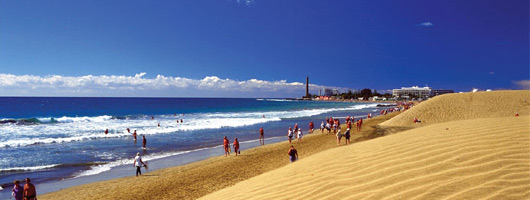The ocean currents have been kind to Gran Canaria and have dictated that the climate is mild and pleasant almost all year round. It even has a marvellous climate in Winter when other parts of the continent of Europe are plunged into darkness and cold.
The ocean currents also dictated that the Trade Winds would blow into the Canary islands almost twelve months a year, moist and fresh breezes that create the Azores anti-cyclone and create one of the best climates in Europe creating a permanent Spring in the Archipelago.

The fact that Gran Canaria is mountainous also plays to its advantages in that the Trade Winds mix with the varied altitudes on the island, producing many different microclimates. So, whereas on the coast, above all in the South the climate is dry and sunny, things change quite dramatically when we climb upwards and inwards.
When we reach higher grounds, the sea no longer influences the climate and the mountains reach the clouds, producing enormous changes in temperature between the tepid areas of the mid-hinterlands with their valleys and sub-tropical forests through to the higher reaches. It has even been known for someone to be toasting on the beach and just one hour’s drive away for other tourists and locals to be cavorting in the snow on the peaks.


The temperature of the seawater is also agreeably warm, fluctuating between 18º in the winter months to 22 the rest of the year. This together with the 2,700 hours of sunshine means that you can truly get the most out of your days down on the beach. The magnificent weather of Gran Canaria makes it into the ideal place for all kinds of open-air sports.
People often make the mistake of thinking that if the winter weather is so mild that the summers must be suffocating hot but again thanks to the Trade Winds, they couldn’t be more wrong. The summer in the Canary Islands is mild thanks to the sea breezes, with temperatures around 24 degrees just perfect for endless days down on the beach.